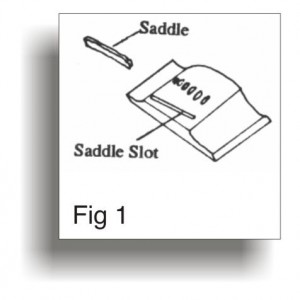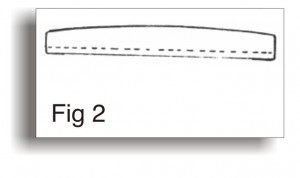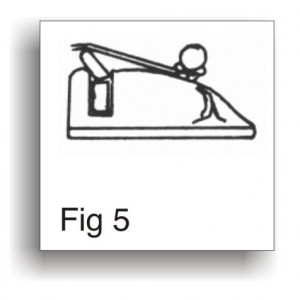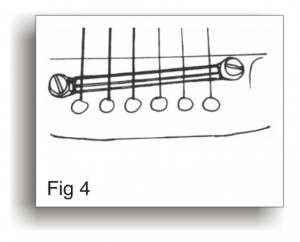FUNCTION OF THE BRIDGE: Sets string length at bridge for proper intonation. Spaces strings at body. Places strings at playing height off fingerboard.
INDICATION OF PROBLEMS WITH THE BRIDGE: Instrument won’t stay in tune. Buzzing of strings on frets. Strings breaking at bridge. Poor intonation.
WHAT TO LOOK FOR: Watch for signs of the saddle leaning or breaking, and look for signs that the bridge itself is coming unglued from the top. If any of these seems to be suspect, have your local repairperson to take a look.
ADJUSTMENTS: Study the diagrams that show the different parts of the bridge. (See Fig. #1) 
Adjusting the OVERALL action of the instrument is done at the bridge. Since the bridge is generally always glued on to the acoustic, the only adjustment we can make is with the saddle. Usually acoustic saddles are one piece, but may be two or more. The saddle is removable from its slot, and should never be glued in. If the action of your acoustic is high and you have adjusted the truss rod, then you must remove the saddle from its slot and cut it down by sanding the bottom.
Draw a line about 1 or 2/32nds up from the bottom of the saddle along its length. This serves as a reference from which to work.(See Fig. #2) 
Sand just to the line, replace the saddle, put the strings back on and tune to pitch and check the action. Repeat this procedure until you are happy with your action.
Because the top of the saddle usually has a curve that matches the fingerboard radius, the only time you should sand the top is to remove divots caused by string wear.
If the action starts out too low or you cut off too much of the saddle, it is better to replace it with a new one of the proper height. You can shim the saddle if you leave plenty of it still in the slot, but be careful not to have too large a shim as this can cause the saddle to “lean over”. (See Fig. #5)

If you are replacing that saddle piece, make sure that the new saddle sits snug in the slot from front to back (thickness of the saddle). If the saddle is too thin for the slot, it will lean as mentioned above. Use your discretion here as to whether you want to replace a short saddle or if you feel you can shim with good results.
Note: that some acoustics have adjustable saddles. These are bridges that have some kind of screw head that sits on both sides of the saddle. (See Fig. #4) By simply turning these adjusters you can quickly adjust the strings up and down for proper action. Always loosen the strings before making these adjustments. Retune, check action and repeat as needed.
REMEMBER: Here we are only adjusting for up and down movement for getting the playability right. We can not adjust the back and fourth movement.
Keep the saddle piece clean and regularly check it for excessive wear. If you keep breaking strings at the saddle, then they may have sharp edges caused by wear. You can lightly sand the top of the saddle to try to remedy this problem or have your local repairperson look at this for you.

